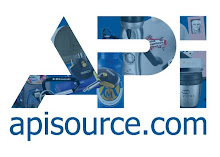Supply costs are always part of the discussion when embroidery comes up. To save on costs, many shops skimp of the quality of the supplies. But at API, as a rule, we don't skimp. This ensures the lasting quality of your logo for years to come. You probably already know you pay a run charge - the cost of actually running the design and sewing onto the fabric. And you already know that for new designs you also pay a digitizing charge - the cost of creating the design and converting it into stitches. But do you know what else we include in that cost? From thread to stabilizers, we're breaking it down.
Thread: The most fundamental part of embroidery is probably the least expensive. We purchase cones of Robinson Anton thread which is sturdy and long lasting. We use it because it is the market's leading thread. They have a vast color selection with a bright high lustrous sheen. These threads wear our machines down less quickly than the rest and the have excellent wash-ability, a huge benefit to our clients. We divide the total cost of the cone by the amount of stitches your design will require to calculate costs. Things like metallic thread, swirl thread and any other special requirements will incur additional costs but you can rest easy in knowing that your design will stand apart from the rest.
Bobbins: Bobbins are one of the most important factors in producing high quality embroidery. Using pre-wound bobbins and bobbin threads ensures that there will be no extra bulk added by the under-thread as it is being sewn into the design. Extra bulk can cause the embroidery to become too heavy and can cause needle breaks. A strong and lint free thread is preferable as this will reduce bobbin thread breaks.
Stabilizers: These are sheets cut to fit your logo and the last step to make sure your design runs smoothly. It's use prevents your embroidery from pulling, sagging or puckering and will add stability to your garment. There are various kinds of stabilizers. E-Zee TEAR® is a non-woven* general use backing. You can tear it in any direction and won't need scissors. We use this on heavier, stable fabrics such as denim or twill. Pulling and tearing the backing will not distort the edge of your embroidery, as long as the fabric is sturdy. Once you tear away the backing, there will be no remnants of the backing left around your embroidery. There is also E-Zee CUT AWAY® which is a soft, stabilizing backing that is ideal for use on knits, sweaters, fleece and any fabric that stretches. It is especially good for use on fabrics that will be worn close to the skin. Cut the excess backing away from the garment as close to the edge of the embroidery as possible. Our reasons for Using E-Zee Cut Away® are its soft texture and stability and the weight availability
Aside from that, we use a special backing for hats. E-Zee CAP® backing is available in two sizes of pre-cut, specifically sized for your finished caps. If you prefer, rolls are available. The sizes, texture and weight of our cap backing will improve the quality of your embroidered design when used on cylinder style cap frames. E-Zee Cap Backing offers a few distinct advantages including the way it improves the crispness of lettering, the insurance of smooth machine operation and the use of an extra fold of the cap backing to get a firm seating on rotating cap frames to prevent registration slips.
Now you are informed in the behind the scenes embroidery scene. And you know what to expect when placing an embroidery order. Go ahead, call us today for your free quote!
800.507.7007




No comments:
Post a Comment